Gentlemen,
So far, the war is going very well. Despite continued trouble from Austrian submarines and raiders, our policy of pursuing big, powerful battlecruisers has been amply justified by recent victories off Syracuse and Sirte, each of which resulted in the destruction of an Austrian battlecruiser. Only three vessels of that type remain in their service now. Moreover, our recent foray into the Adriatic has gravely damaged their military resources and relieved pressure on the British in Dalmatia.

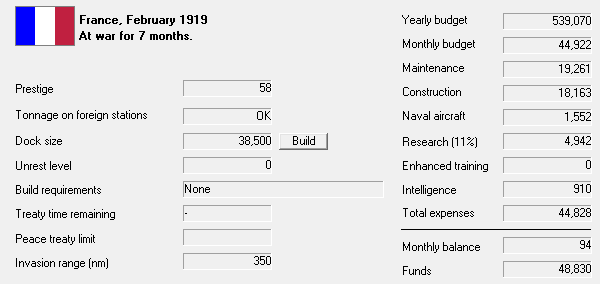
Currently, our biggest challenge is the threat to our commerce. We have recently commissioned a number of anti-submarine trawlers, and have more under construction. The raider threat is harder to handle, as we continue to need modern CLs for fleet duties as well as trade protection. Losses in that category to mines and submarines have not made the problem easier. But we remain optimistic, and hope to bring Austria to the peace table as soon as possible.
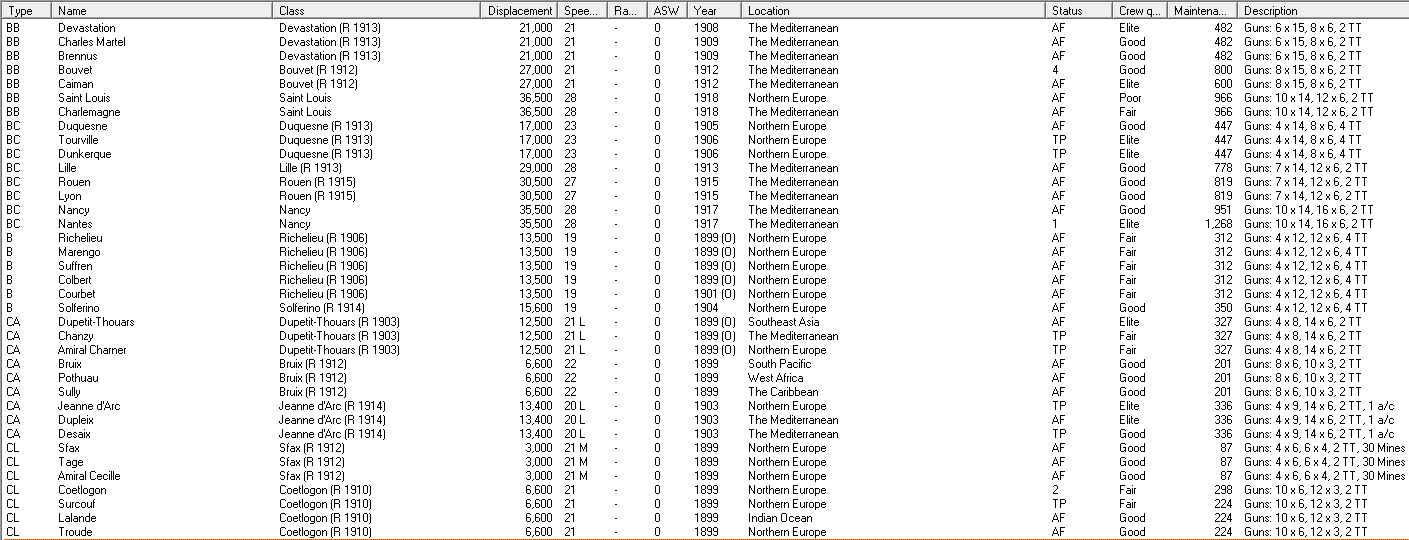
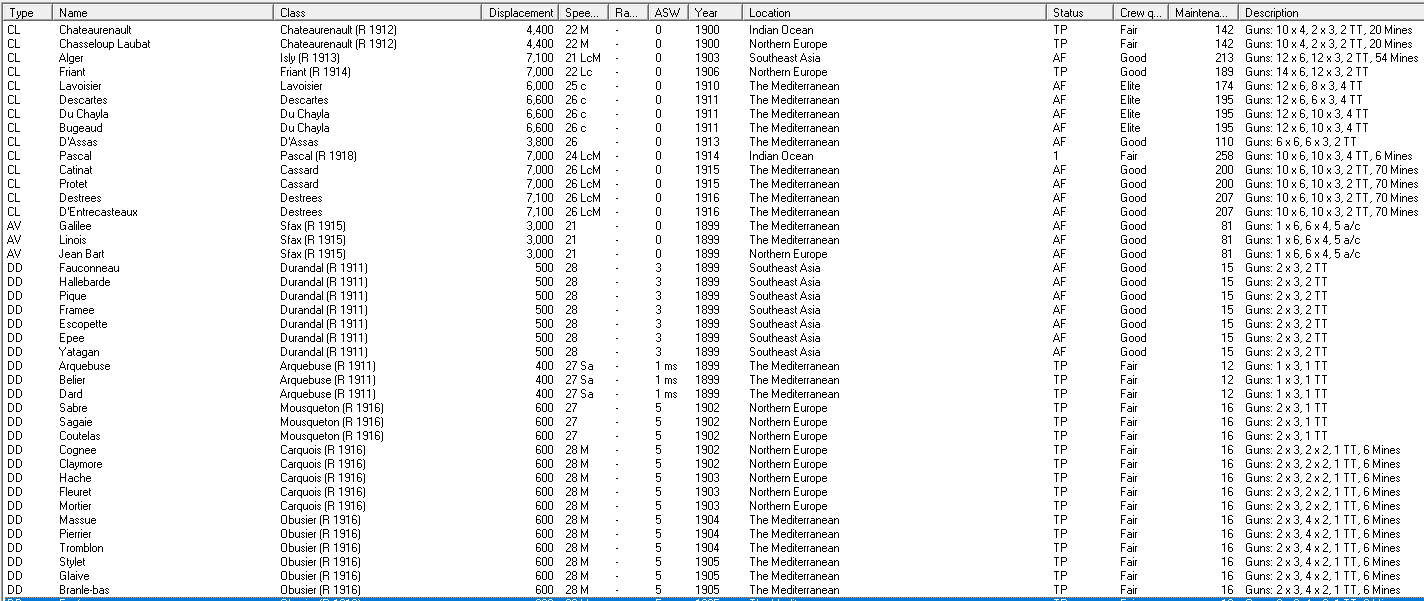
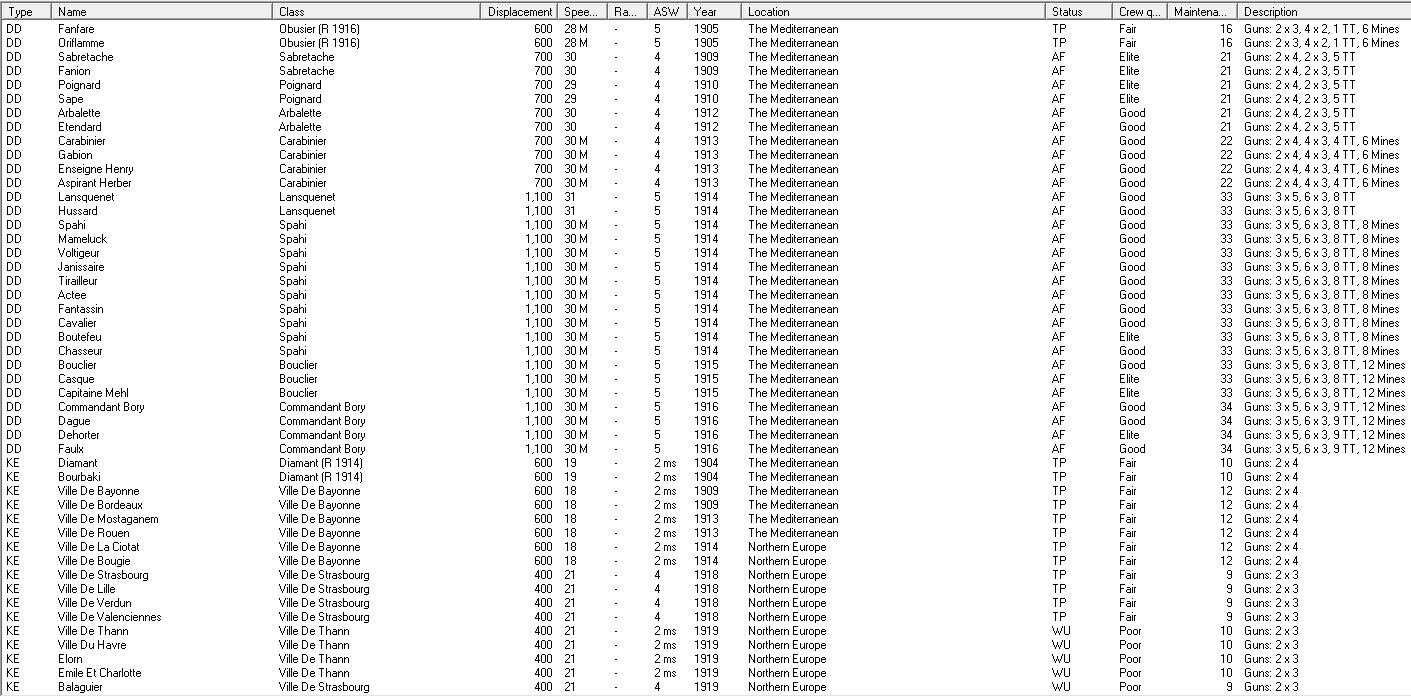
Our current fleet

Ships under construction
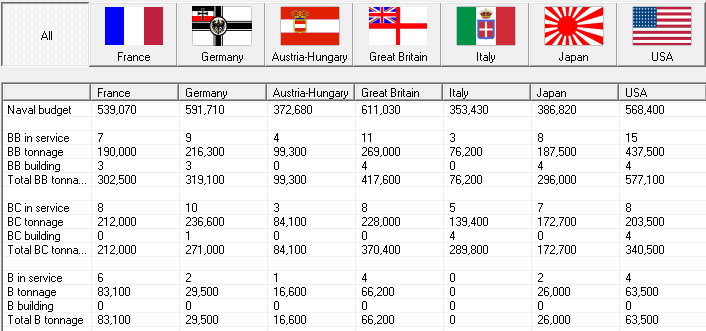
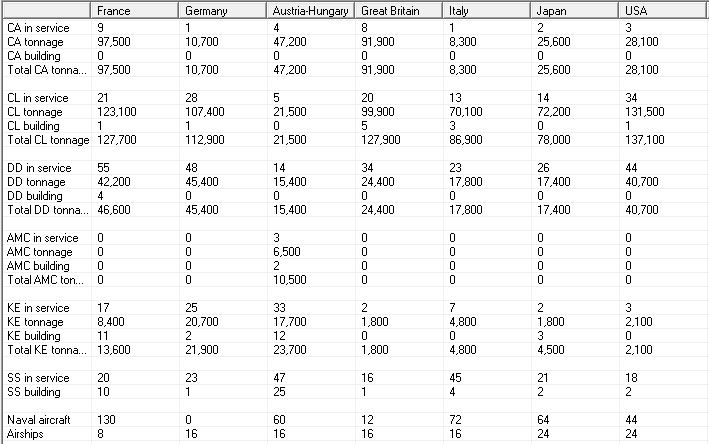


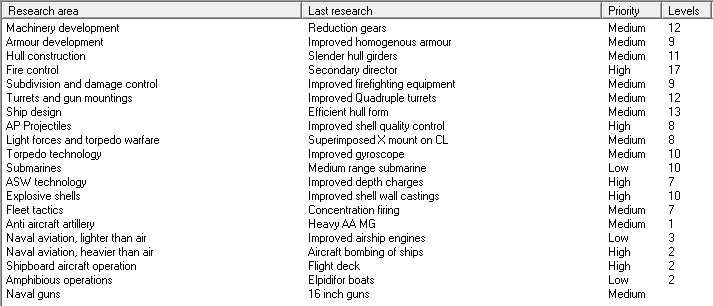
August 1918
1 SSC commissions. CL Pascal finishes her reconstruction. Dewoitine D.60 selected as our new flying boat prototype. CL Isly sunk by an Austrian submarine. BB Saint Louis hits a mine and will be in dockyard hands for 6 months. In revenge, we get 4 of their subs and 6 merchant ships, and a cost of 5 merchies each to raiders and subs. DDs Espingole and Arc laid down. AH lays down 12 KE, 1 AMC, US 1 BC. AH commissions 1 BB, 4 KE. 230 VP for blockade. 4 Ville De Thann class minesweepers and 2 more Ville De Strasbourg KEs laid down.
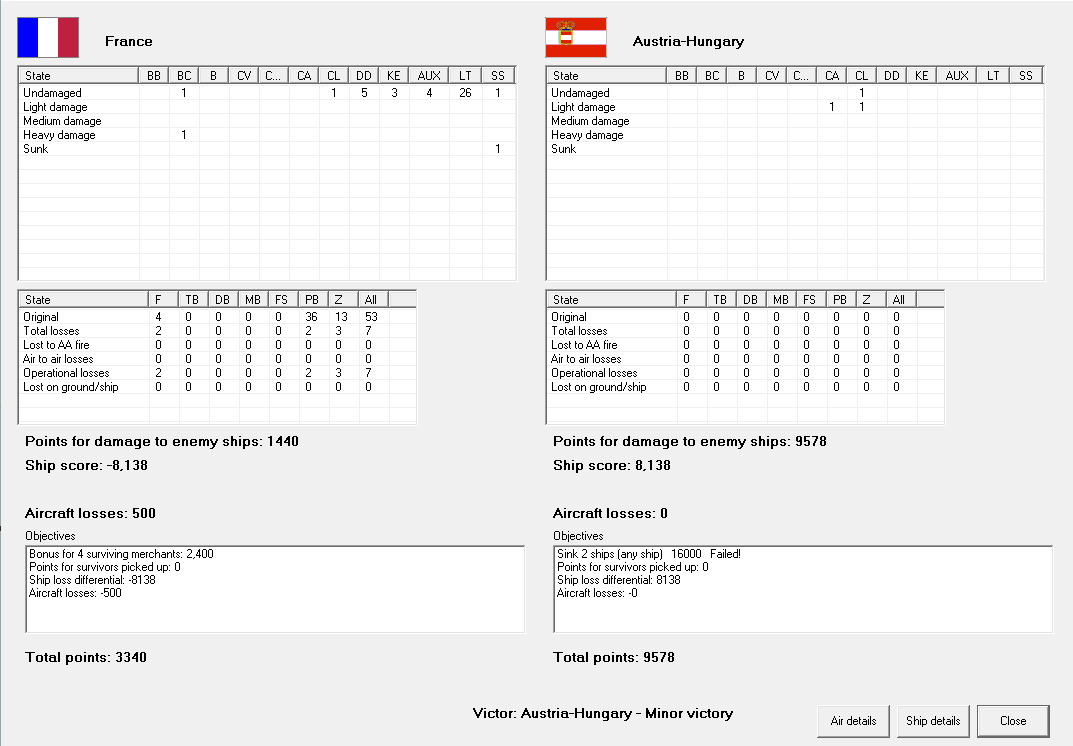
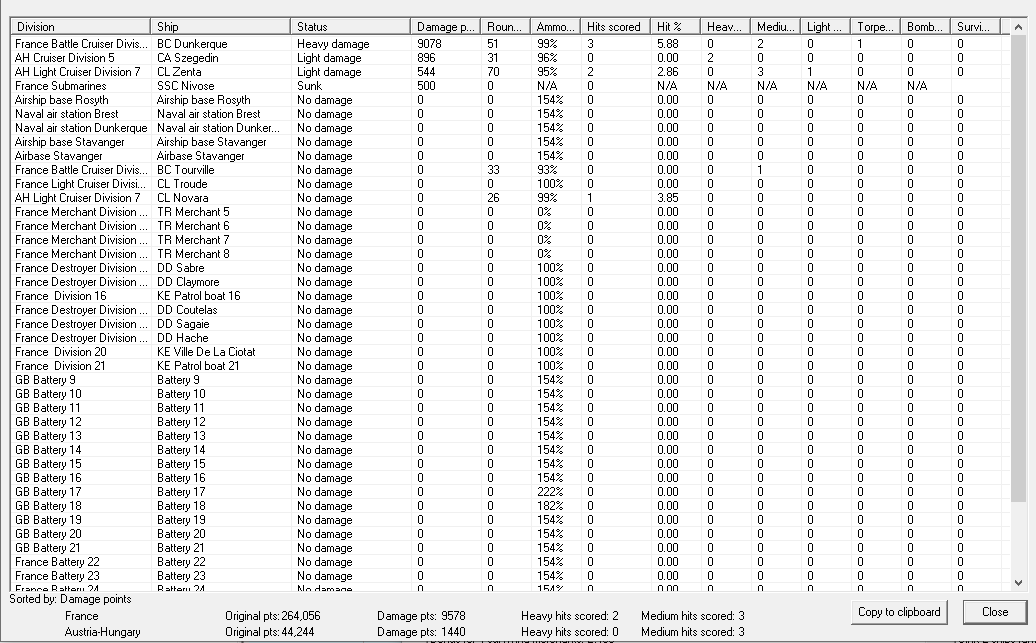
Coastal raid off Western France. CL Troude leads BCs Dunkerque and Tourville, who encounter an Austrian formation of 1 CA and 2 CL at dusk. Unfortunately, night falls before more than a few hits are landed on the Austrians. A chance encounter late at night sees the Austrian ship escape. BC Dunkerque was torpedoed on her way home, and one of our submarines failed to return, giving the Austrians the victory. 746 VP for them, 316 for us.
September 1918
Private shipbuilding expands max dock size by 1000 tons. We commission 3 submarines. Our subs sink 3 ships for one loss. We kill 1 sub, lose 16 merchies to subs, and 3 more to raiders. AH lays down 1 AV, 1 AMC, Japan and US 1 BB each. AH commissions 3 KE. 220 VP for blockade. 4 SSC laid down.

CA Chanzy intercepts an Austrian CL raider. While it lands a few hits, the Austrian cruiser is too fast and pulls out of range. Ultimately, a marginal victory for us, giving us 98 VP and them 0.
October 1918
BB Charlemagne finishes working up. AV Cosmao sunk by an enemy submarine. We lose 16 merchies, half to subs and half to raiders, and 1 sub of our own. Germany lays down a KE, AH an AMC and 6 KE, the UA an AV. AH commissions 1 KE. 220 VP for blockade. Airbase construction begun at La Rochelle.
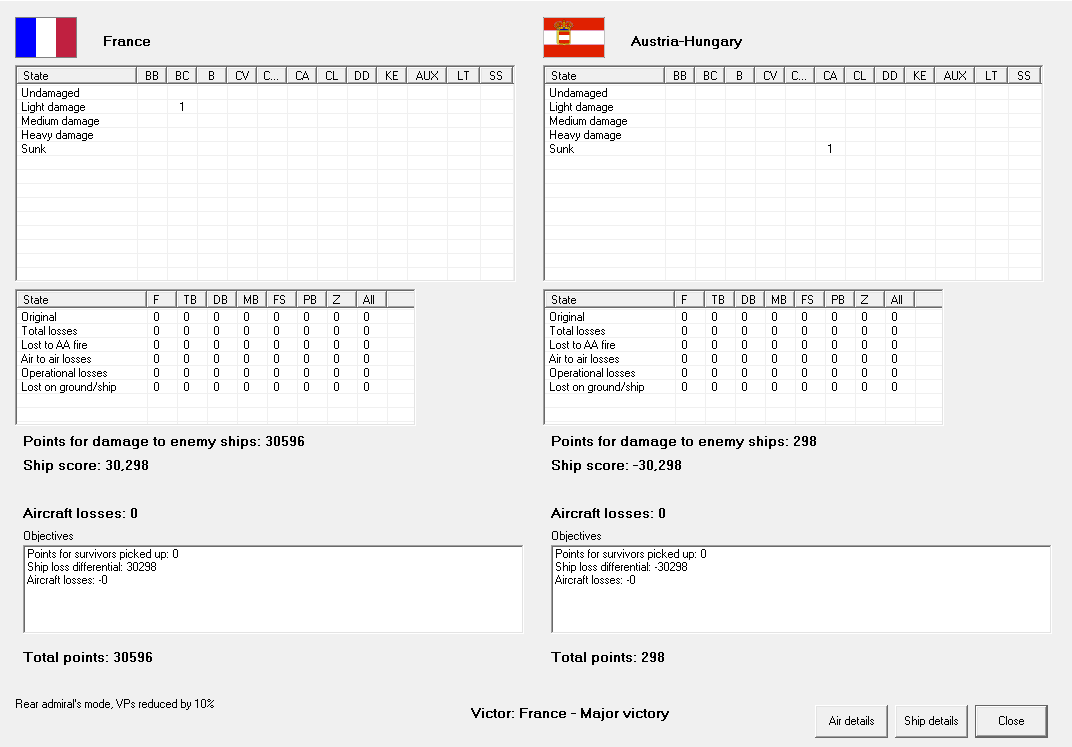
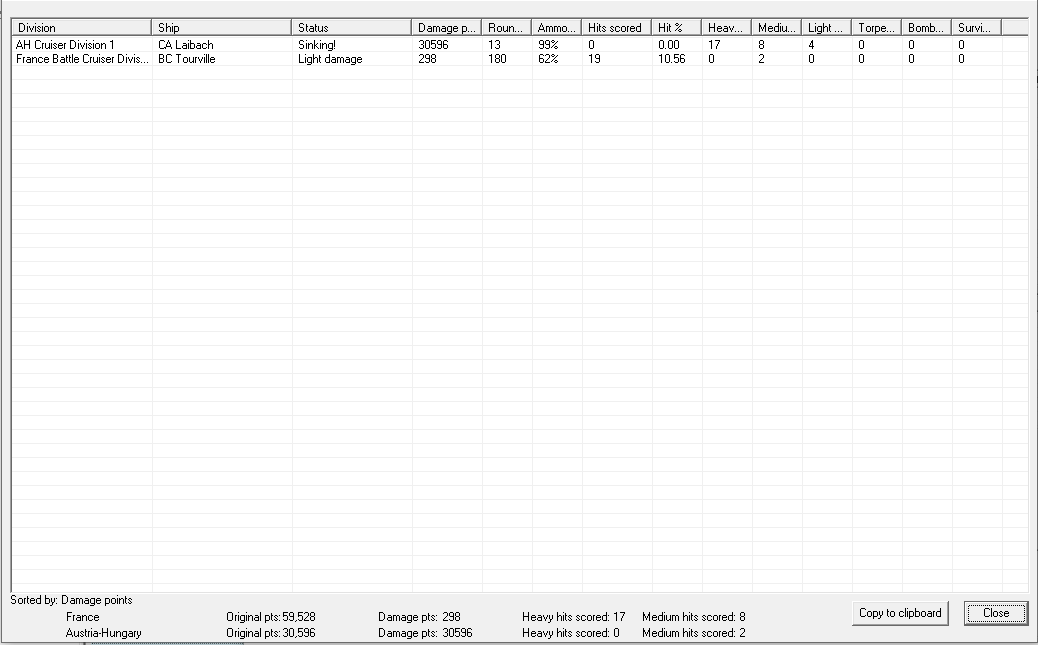
BC Tourville intercepts an Italian CA attempting to run the blockade, and manages to hit it several times, slowing it enough for Tourville to come up on it. Darkness briefly hides the enemy ship, but then Tourville finds her again and pounces, bringing her to a halt and ultimately sinking her. A major victory, gaining us one prestige, 2,051 VP and giving them only 57.
November 1918

4 KE commissioned. Our spies steal blueprints for the new British CL Canada. Breakthrough: Heavy AA MG. Dewoitine D.60 enters service. DD Cimterre sunk by enemy submarine. CL Coetlogon damaged by a mine, while one of our mines sinks DD Tatra. Our subs sink 2 merchies, while theirs sink 7, along with 3 from raiders. We get 3 of their subs. US lays down 1 BB. AH commissions 5 KE, 1 BC, Italy 1 AV, UK 1 CL. 220 VP from blockade. 4 Ville De Strasbourg and 2 Ville De Thann class KEs laid down.
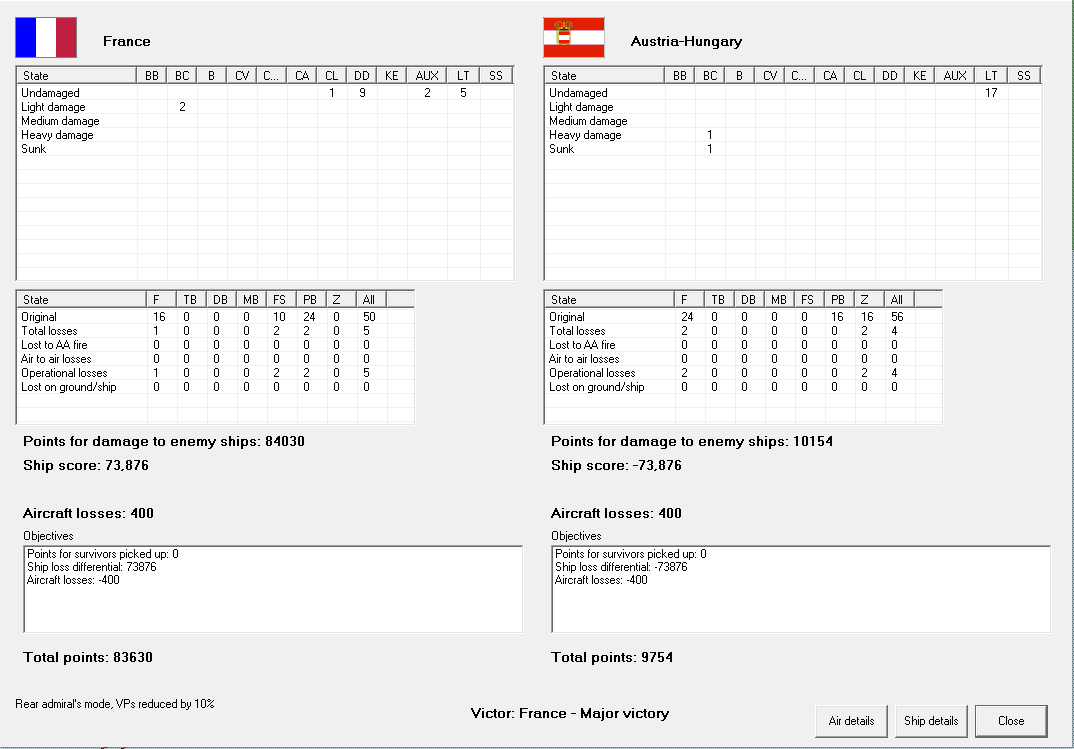

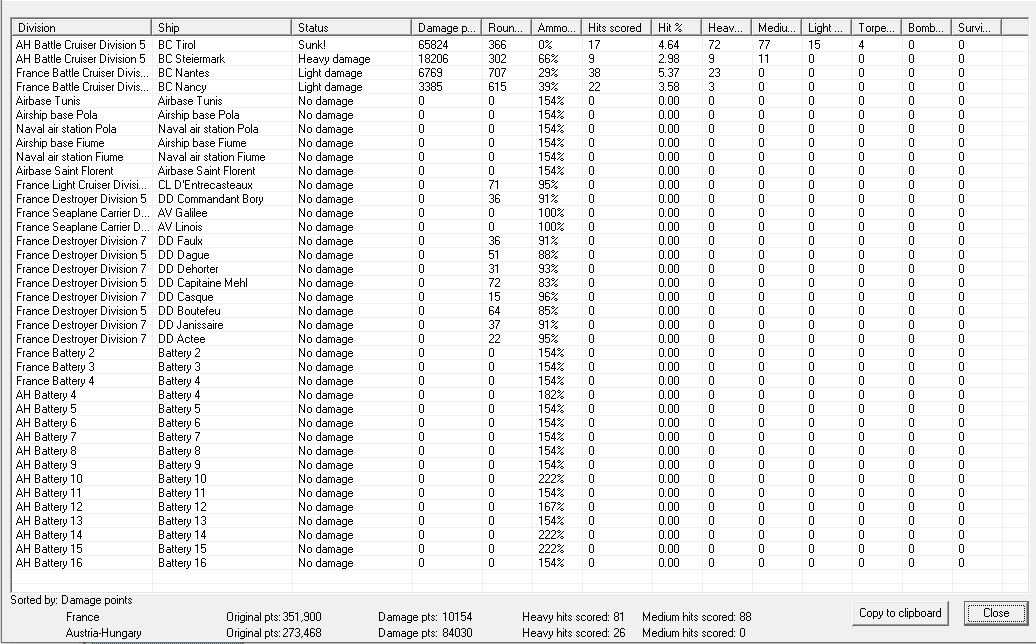
Cruiser battle off Sicily. 2 of our BCs, with screen encounter a pair of Austrian ships. The Austrian vessels retreat to the north, but despite uptake damage to Nancy, we stay with them, and slowly begin to batter them into submission. One is finally lamed, and the battlecruisers pounce, although the other gets away as darkness falls. Destroyers eventually overtake and torpedo the enemy ship, putting her on the bottom. A major victory at the Battle of Syracuse, granting us 2 prestige and 5,154 VP to only 757 VP for them.
December 1918

5 KE commission. Our spies steal the blueprints for BB Montana. Breakthrough: Improved depth charges. The blockade is causing food shortages in Austria-Hungary. CL Cassard sunk by a mine in the Med. We each lose 2 subs this time, with theirs taking 7 ships and ours 1. We also lose 7 ships to raiders. We lay down 4 new 600-ton minesweepers and 2 more Espingoles. AH lays down 3 KE, 1 AMC, Italy 1 BC. AH commissions 1 AMC, 9 KE. 210 VP for blockade.

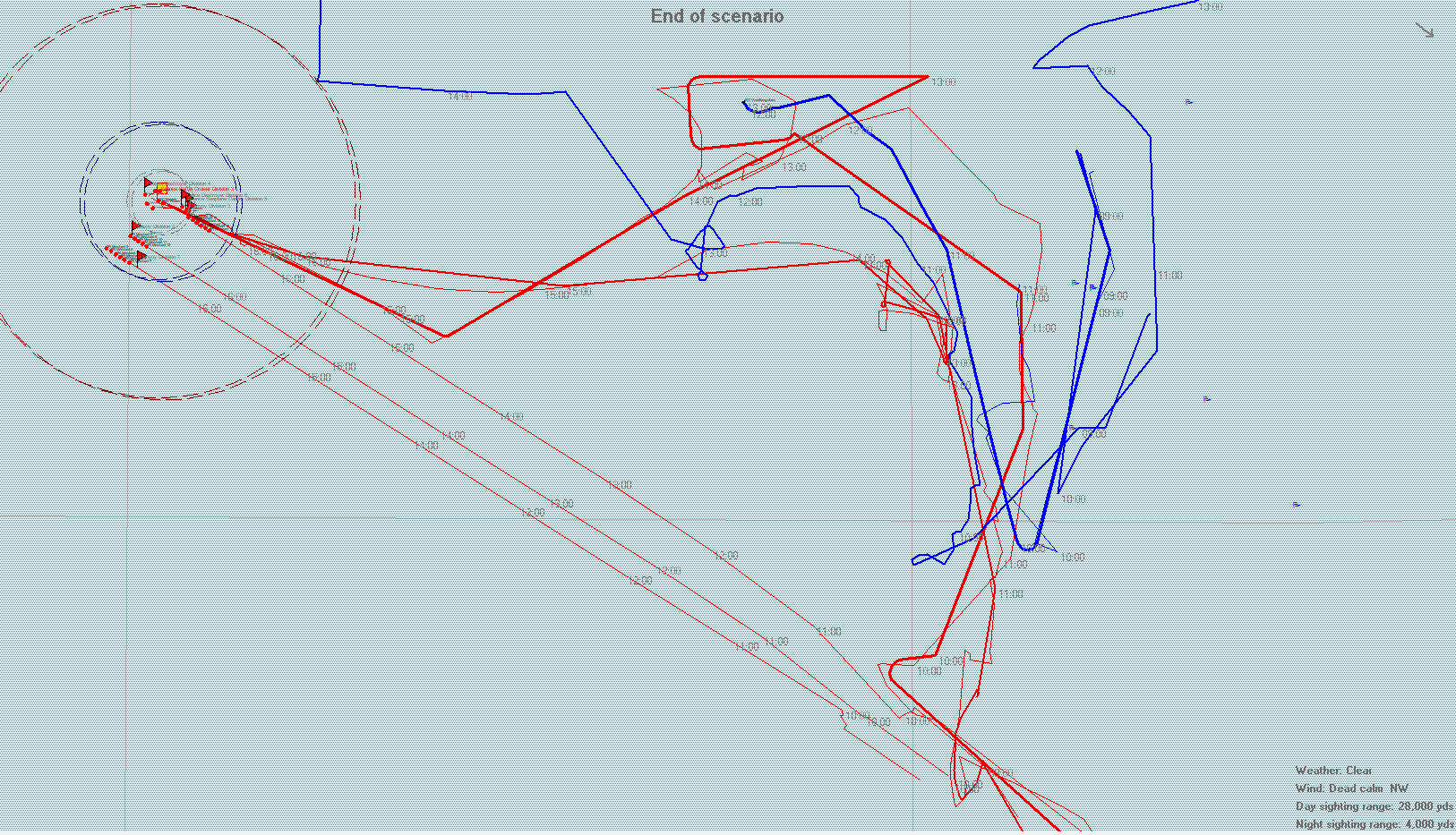
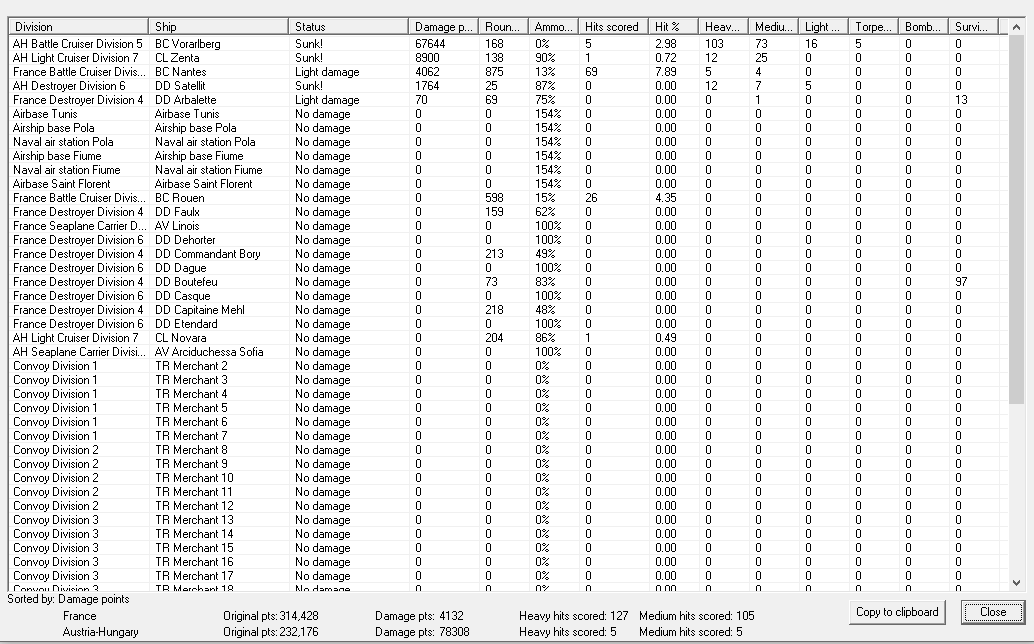
They decline a cruiser action in the Adriatic, granting us 750 VP. We instead find ourselves defending a convoy with 2 BCs. They quickly find themselves under attack from an Austrian BC with CL support, and counterattack vigorously. A destroyer finds itself under their guns after a failed torpedo attack, and is blown apart by heavy guns. They manage to slow the Austrian BC, eventually closing to pound it while destroyers move in for torpedo attacks. The BCs also catch an Austrian CL, and destroy it. The Battle of Sirte is another major victory, granting us two prestige and 5,418 VP while they walk away with only 360 VP.
January 1919


Our spies steal plans for Japanese AV Hoten Maru and Italian BC Elba. BB Bouvet is torpedoed and will be in dockyard hands for 4 months. B Magenta is sunk by a mine in Northern Europe. We get a single merchie, and lose a sub. Their subs and raiders each get 9 of our ships. AH lays down an AMC. Germany commissions a KE, AH 1 AMC, 4 KE, Italy 1 CL, Japan 1 BB. 220 VP from blockade.
Austria declines a fleet battle in the Strait of Otranto, giving us 9,630 VP, and then refuses to oppose a bombardment, giving us another 5,760 VP.
April 1919
Gentlemen,
We are victorious over Austria! Their inability to face us at sea lead to a swift victory, reducing tension with the other powers as well. At this point our greatest problem is the usual one of insufficient budget. This is made worse by a large number of new options we would like to investigate, including upgrades to our cruisers and destroyers, as well as refits to the battle fleet.
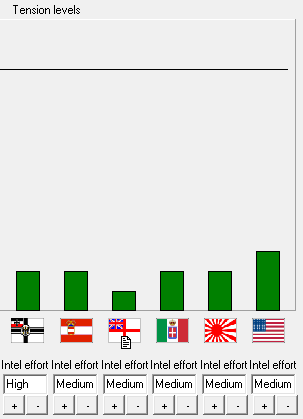
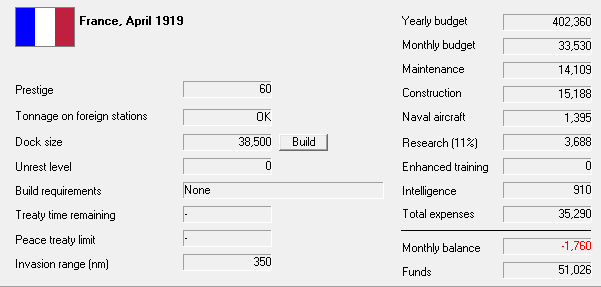
Another milestone is the commissioning of our first carriers. Gueydon and Montcalm have just entered service, although the war ended before either of them saw combat. This gives us a decisive edge over any other power in naval aviation, and our researchers report that they are close to developing purpose-built carriers as well.

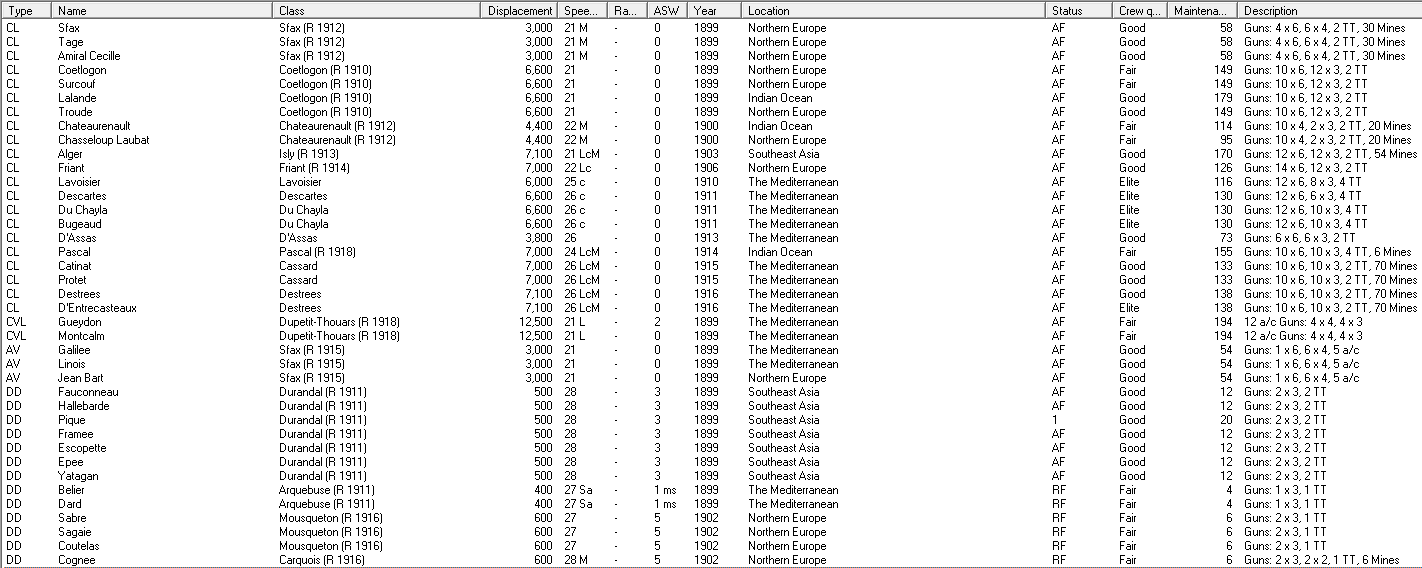
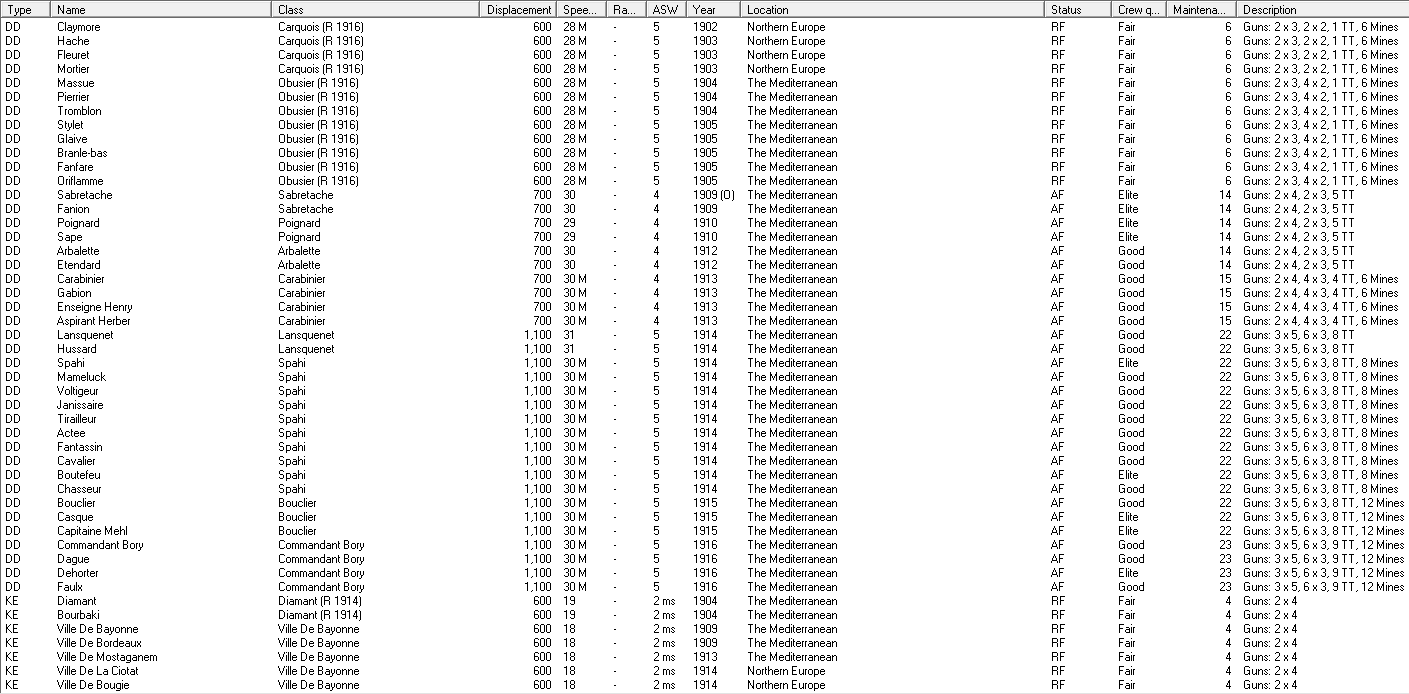
Our current fleet

Ships under construction




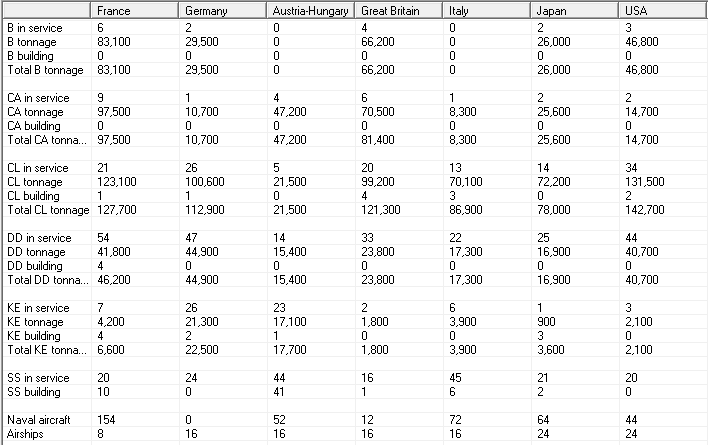
February 1919
CVL Gueydon finishes reconstruction. 2 KE commission. Parliament authorizes a new war loan, increasing the naval budget. Breakthrough: Superimposed guns on DD. An enemy sub sinks a KE. DD Arquebuse hits a mine and sinks. We sink Austrian B Erzherzog Friedrich with a mine in the Med. We lose 5 merchies to subs and 4 to raiders, but sink 3 subs. British operations add 210 VP. Germany commissions 1 KE, AH 5 KE, UK 1 CL, Japan 1 AV. 260 VP for blockade. Design work begins on new CL Cosmao (modified Guichen) and DD Rapiere (Espingole with superimposed forward gun).
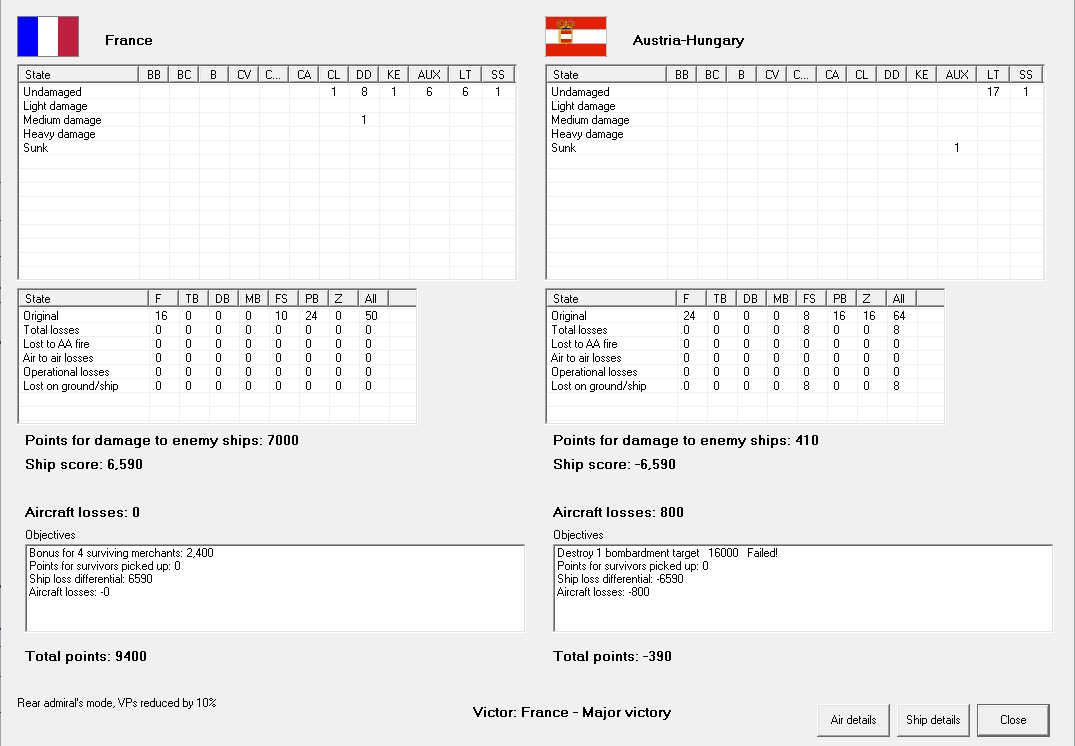
Austria declines to oppose a bombardment mission against Albania, netting us 5760 VP, then declines a cruiser action in the Ionian sea, giving us another 4800 VP. Lastly, their fleet rushes for cover in the southern Adriatic, giving us 9165 VP. We finally fight a destroyer action off Corcera, where several of our destroyers sink an Austrian AV. 734 VP for us, 0 VP for them.
March 1919
CVL Montcalm finishes reconstruction. 5 KE commission. We sign an armistice with Austria, gaining large repatriations. Loire 63 is selected as our new fighter. Germany lays down 1 KE, Japan 1 BB, US 1 CL. AH commissions 1 AMC, 5 KE.

Comments
That commerce warfare is pretty annoying, but between the food shortages in Austria and that mounting VP total, hopefully it won't trouble us too much longer.
Have our aircraft had any noticeable impact? I see several battles list operational losses, which I take to mean they are in fact in the sky at some point.
So far, we've seen AVs present at both Syracuse and Sirte, and at Sirte in particular they gave me a valuable warning of where the enemy was coming from. I haven't really commented on them specifically because they're still at the "buzz around and observe" stage, but they have proved useful enough I wouldn't mind converting the other three Sfaxes. Once the fighter competition currently going finishes, I'll ask for new floatplanes, too.
Why does Nantes cost ~300 more than Nancy? A difference in status? (I'm not sure what the status of '1' refers to for Nances)
@DuskStar I think the 1 indicates that it will be in the yard for a month (see Bouvet, which was recently torpedoed) which probably explains the difference in cost.
The loss of Isly and Cassard is painful, given our shortage of cruisers. Was Isly operating in the Far East when she was sunk? How can the Austrians be operating submarines there? I am also extremely suspicious about the sinking of the Magenta. I think it is possible that the Germans are providing significant support to our enemy, and may already be covertly attacking our ships. I understand if we cannot currently respond, but if we find evidence of their involvement it cannot go unpunished forever.
I'm a little bit disappointed that our aircraft haven't made it harder for their subs and raiders to operate against us, though the D.60 might be more effective. Would it be worth transfering our airships from Stavanger to Sardinia to give us more eyes (with greater endurance) over the Med? Converting the remaining Sfaxes to AVs might also help, and they are a bit past it otherwise.
I'm glad our BCs have performed well, and looking at the San Giorgio class I expect the Italians are too. It's probably unsurprising that whoever is in charge over there now would look to emulate our designs. I'm also pleased with Tourville, though it was up against a lighter opponent.
@DuskStar
Nantes took several hits at Sirte, and as Alexander suggests, the extra cost is because she's in yard hands. 1 means she'll be back on active duty next month.
@Alexander
Yes, Isly was in the Far East, and I have no idea how the Austrians got a sub out there. Headcanon is that there was a reporting mistake, and she was actually sunk by a mine.
Because of the way the game works, we can't really transfer airships around. They're tied to the bases, and we don't have one in the Med. I'd suggest focusing on fixed-wing aviation if we want more coverage. Building the base on Rhodes would be a good start. We've seen more conflict near it than I expected.
The Duquesnes have proven more useful than expected. There's still a lot of smaller cruisers around, and they either drive them off or slow them enough to sink them. Either way is a big win for us. We might even think about reengining them for more speed (which could be quite helpful when it comes time to, say, deck them over).
Okay, so it's not worth moving the airships. A base on Rhodes, and perhaps more Sfax/D-T conversions sounds a better choice. I don't know how the game decides where battles take place, but Rhodes would be very relevant if either Russia or Turkey were in the game. Maybe there are a variety of different 'battlefields' per ocean which the game chooses between without regard for which powers are involved.
I'm open to spending a bit more on the Duquesnes - how much would an engine upgrade cost, and what speed would they reach? There are still quite a few battlecruisers (though two fewer now) out there less powerful than our 'City' type BCs that would nevertheless be a serious threat to a Duquesne, however modified, so I do worry about them being caught and sunk by a more modern ship. Turning them into carriers will hardly leave them less vulnerable, but then you kind of expect carriers to come off second best in a gunfight.
It might be a while before we can afford it, but would there be a case for building some very heavy cruisers, smaller than any Alaska, perhaps along the lines of the Deutschland class cruisers. Something that would remain effective against other large cruisers through the 1940s, but less than half the cost of a proper capital ship? Obviously cheaper Guichen type cruisers are more urgent, given the number of cruisers nearing retirement.
CAs can go up to 19900 tons and 9.5" belt. In the past I've had great success with these "maximum cruisers" armed with 4x4 8" guns, though this may be mostly due to RtW's scenario generator giving favorable matchups to individually powerful cruisers.
It does disappoint me that RtW's scenario generator has different hard-coded rules for how it treats CAs, BCs, etc., so part of optimal gameplay is tweaking your design so it fits in a particular category. This makes it resemble real-world history more closely, but detracts from it as an open-ended simulation.
Reengining is going to cost about 1300/month for 12 months, and I can get us to 25 kts with 260 tons left over. Maybe slap some floatplanes aboard or something. That's expensive, but there's a 24-kt threshold for actual CVs.
As for battlefields, those do exist, although the ones that get picked are based on the combatants. You see different ones based on who you are and who you're fighting. I think it even gets tweaked based on who owns what. I can take a look at the CA designs. We could quite easily do a design with two quad 8" turrets.
Superfiring CA turrets should come along pretty soon now as well; I think a miniature Dunkerque could do quite well without being too grossly ahistorical.
That upgrade is nearly the cost of a Guichen, and while it's be ready sooner we'd be down a ship for a year (though I guess that means we wouldn't need to pay maintenance, which saves a bit). To be honest I'd probably hold off until we are ready to turn them into carriers. I would start that soon though, to give us the best chance of having them ready before any war with Germany.
You showed us a 2x4 8" cruiser back in may 1915, but I was thinking of something even larger. Big enough to defeat something like a Baltimore. Perhaps not quite 19,900 tons with sixteen guns, but maybe using something a little heavier than an 8". I hear we have a good 11 inch available...
Spotted a post on the forums giving the restrictions on big-gun cruisers (to avoid them being classified as BC rather than CA):
Pretty strict. There's 9" and 10" guns which don't have these restrictions, but it seems like these are disfavored by the RtW penetration table with only marginally more than 8" guns, perhaps because there were relatively few prominent examples of 9" and 10" naval guns in this historical era. I suppose the ghost of the WNT still haunts us even when treaties are not technically active in a particular game. Though I don't recall what our current gun quality situation is.
@Evil4Zerggin I was thinking of the Deutschland class as an example of what I was after, so it's nice to know that's an option. Those limits are quite restrictive of our freedom to build ahistorical designs, in a world where the treaties never existed. Interesting that we now have an official ruling on what class an Alaska is.
I wonder how it would effect the game if you were able to choose the hull symbol freely? E.g. downgrade our Duquesnes to CAs because they are too old to cut it as BCs, or build huge 3,000 ton 'destroyers'. It might lead to some unfair match ups, but if you use what are effectively dreadnoughts as light cruisers then you won't be able to cover everywhere you might want, or afford much of an actual battlefleet.
I've generally felt the scenario generation to favor quality over quantity; outside of fleet battles, the "quantity" side often seems to get a smaller proportion of their total assets (but I haven't done controlled trials so take this with a grain of salt).
Ship design also favors heavier ships in gun battles with a lower proportion of tonnage needed to reach a given amount of speed and armor as displacement increases.
Even without the above two points, I feel that small battles tend to favor quality. Even if your 20k tonner gets put against two 12k tonners, it's far more likely than not that you will inflict debilitating damage to one of their ships first, at which point the other has to choose between leaving their compatriot to their fate, or sticking around which will most likely merely result in completing the annihilation of their entire force given that they've lost close to half of their firepower and their ability to maneuver as a unit.
(Interestingly, the opposite is currently true in Ultimate Admiral: Dreadnoughts---there the weight advantages for speed and armor on heavier ships are smaller or non-existent, you are guaranteed a proportionally larger number of ships in battle if you spend less on each one, and ships with lots of turrets are much easier to hit than ships with few turrets. As such, the balance is much further towards quantity.)
Quantity does win out in blockades, where your blockade score only depends on the hull classification and not on displacement or quality at all. However, I suspect that the net effect is not so much to straightforwardly help quantity so much as encouraging a "high-low mix", with a large number of cheap, light-for-their-type ships for blockades, trade protection, ASW, etc., combined with a small number of heavy-for-their-type ships to do the direct fighting.
Finally, AFAICT the AI doesn't react to your ship design choices.
All-in-all, RtW seems to be based around some strong assumptions around doctrine, with the AI and scenario generator having quite limited capability to react if the player doesn't follow these implicit rules. (To be fair, a more adaptive system would not be a trivial ask.) Choosing hull symbols freely would certainly increase the degree to which these could be gamed; basically you would try to classify your ships such that the scenario generator tends to assign you more tonnage and more appropriate ships in each of the potential battle types. I think there could be a game in which hull symbols implicitly represent doctrine choices and you would be forced to make realistic tradeoffs in choosing them, but I don't think RtW is currently set up to handle that well.
Interesting, and useful to know, though I might start worrying that I'm trying to play the game rather than make good choices (with the benefit of foreknowledge) about naval procurement. It doesn't really seem unfair to have larger ships benefit from the real advantages that they had historically, but you should suffer the consequences if too few are available to cover all the tasks, and a high-low mix should sometimes result in a more balanced enemy cruiser defeating your cheaper ones rather than falling victim to whatever monster you have created by gaming the design system.
Yeah it's always hairy business trying to extrapolate the results of a simulation back to real life, especially once you start trying to push the limits of the ruleset. I'm reminded of a quote from this forum comment:
We managed to bring Austria to the table in March. We're victorious, and tensions worldwide have plummeted. I guess it's time for the traditional cutting of the fleet. Still, not a bad job overall.
April 1919 is up now.
Looks like we're the only power still running old-style battleships - time to retire those soon?
Most of the other countries still have a few 'resistables', but yeah, we should scrap some and mothball any we want to keep. We might also send the Duquesnes or even the Devastations to the reserve. There are probably other ships that want scrapping too - the remaining Arquebuses and Durandals for instance. Is it worth converting the rest of the Sfaxes as well as the D-Ts?
I was going to propose upgrading the 700-ton DDs and sending them to SEA to replace the remaining Durandals. I've only mothballed the escorts, but didn't mean to suggest that we keep everything else in commission. The Sfaxes will be potentially useful, as fighters have to pull double duty as scouts and for our own protection.
Okay, that sounds good. We've got quite a lot of upgrading and conversions to do, between the Sfaxes, D-Ts, eventually the Duquesnes, as well as cruisers and those destroyers, but that's cheap compared to building new ships, and with tensions low we can spare them while they are in the yard. If we do have the budget for new ships (which might not be until the Oceans are finished) I'd stick to smaller ships, CLs, DDs and KEs until we can retire at least everything that was in service around the turn of the century.
Also, aren't we due for general oil-firing availability around now? I agree with the focus on lighter units for the time being (maybe including looking at what we might want CA-wise again), especially since the German DD fleet looks like it's catching up to ours, but I'm leery about laying down a lot of new coal-fired ships now.
My understanding is that we have been able to build oil fueled ships for years, but we have no reliable source of oil. Perhaps Britain can help us out here?
Unfortunately, there's no way to ask the British for oil. Either we have it or we don't, and I don't know when it becomes available for those who don't. But we have good trade with those who do, and I may replicate this by hacking oil into Libya or something.
I just tried out a Chin China game, and global oil trade opened around 1922-1923. So probably soonish.
Is there any downside to mothballing ships pending refit? That'll be good for a few hundred per month in savings until the refits start.
Not really. That's a good idea, at least for our older ships. We probably need a few in active service to make sure nobody gets any ideas.
Broad plan for play tonight:
Mothball all remaining Bs. No scrappings yet, although this will change when the Oceans begin to commission.
Reserve the Devastations, along with the Duquesnes and all older ships.
Convert another pair of DTs into CVLs.
Modernize 700 ton DDs, use them in SEA to replace remaining Durandals. Modernize CLs and BBs to make use of various recent innovations.
Also, I plan to cut a deal with the British to find oil in Libya.
I'll second ADifferentAnonymous's suggestion to mothball any Dupetit-Thouars or Sfaxes we aren't converting yet, and maybe the Duquesnes, if we can spare them, until we are ready to get to work on them. Plan sounds good though.